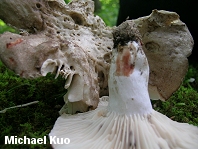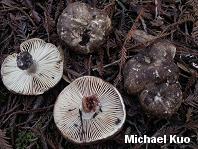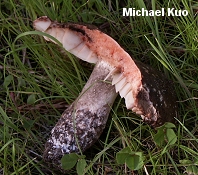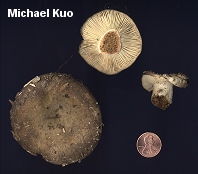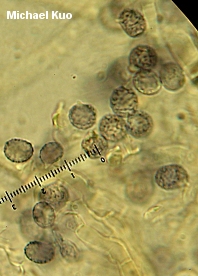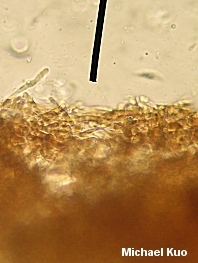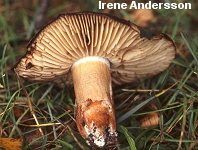| Major Groups > Gilled Mushrooms > Pale-Spored > Russula > Blushing & Blackening > Russula dissimulans |

|
Russula dissimulans [ Basidiomycetes > Russulales > Russulaceae > Russula . . . ] by Michael Kuo This blushing russula features a whitish cap that soon becomes brown, and gills that are often (but not always) widely spaced. It is often called "Russula nigricans" in North American field guides, but that species is European, and it may or may not be the same as the mushroom found on our continent. Russula dissimulans should probably be separated from the very similar Russula densifolia on the basis of the thickness and structure of the skin (officially the "cuticle") of the cap. The dissimulans cuticle type consists of a tightly packed, fairly thin layer of horizontally interwoven elements--while the densifolia cuticle type is very thick and features a lower layer like the dissimulans cuticle, but an upper layer of more erect, less tightly packed elements, embedded in a gelatinous matrix. Now, perhaps I am subject to tactile hallucinations, but I'm pretty sure that I can feel the difference between these two cuticle types with my fingertip, when I am holding fresh specimens. The dissimulans cuticle has a waxy, brittle feel to it, while the densifolia cuticle type feels softer and not at all waxy. By classical definitions, Russula nigricans has widely spaced gills and small spores (typically measuring under 8 µ in the longest dimension), while Russula densifolia has close or crowded gills and larger spores (approaching 11 µ in the longest dimension). Shaffer (1962) believed that Europe's Russula nigricans differed from the North American version, which he named Russula dissimulans, by having more distant gills, smaller spores (measuring 8 µ in the longest dimension) with lower ornamentation (0.1-0.3 µ high) and "inconspicuous gluten" in the cap cuticle. However, anyone who has collected mushrooms in this species group a number of times knows that these features are subject to variability and that they intergrade between collections (sometimes even within a single collection)--and, different versions of these characters are recorded by different authors. For an account of these frustrating differences see Roberts (2008), who concludes: "Clearly, if there is a difference between the European R. nigricans and the North American R. dissimulans, the characters of gill spacing and spore size are insufficient to separate the species." Description: Ecology: Mycorrhizal with hardwoods or conifers; growing alone, scattered, or gregariously; summer and fall (and over winter in warm climates); widely distributed in North America. Cap: 5-20 cm; broadly convex when young, later flat with a central depression, or shallowly vase-shaped; dry; more or less smooth, but with a waxy feel; initially whitish but soon discoloring to brownish, ashy gray, or brown (eventually almost black); the margin not lined; the skin not peeling easily. Gills: Attached or running very slightly down the stem; thick; distant or nearly so; white to cream; bruising and discoloring slowly reddish, then grayish to blackish. Stem: 3-8 cm long; 1-4 cm thick; whitish at first, but soon darkening like the cap; bruising reddish, then blackish over the course of as much as half an hour; fairly smooth. Flesh: White; hard; bruising promptly or slowly reddish on exposure, then blackish over the course of as much as half an hour or more. Odor and Taste: Odor slightly fragrant, somewhat unpleasant, or not distinctive; taste mild, slightly acrid, or acrid. Chemical Reactions: KOH on cap surface negative. Iron salts on stem surface negative to weakly grayish. Spore Print: White. Microscopic Features: Spores 6-11 x 6-9 µ; widely elliptical to subglobose; with ornamentation under 1 µ high, connectors forming partially to completely reticulate areas. Pileipellis REFERENCES: Shaffer, 1962. (Burlingham, 1915; Beardslee, 1918; Kauffman, 1918; Smith, Smith & Weber, 1979; Shaffer, 1962; Kibby & Fatto, 1990; Lincoff, 1992; Barron, 1999; Roody, 2003; McNeil, 2006; Miller & Miller, 2006; Binion et al., 2008; Roberts, 2008.) Herb. Kuo 07259404, 09040202, 02200303, 08050302, 08030403. This site contains no information about the edibility or toxicity of mushrooms. |
© MushroomExpert.Com |
|
Cite this page as: Kuo, M. (2009, February). Russula dissimulans. Retrieved from the MushroomExpert.Com Web site: http://www.mushroomexpert.com/russula_dissimulans.html |
